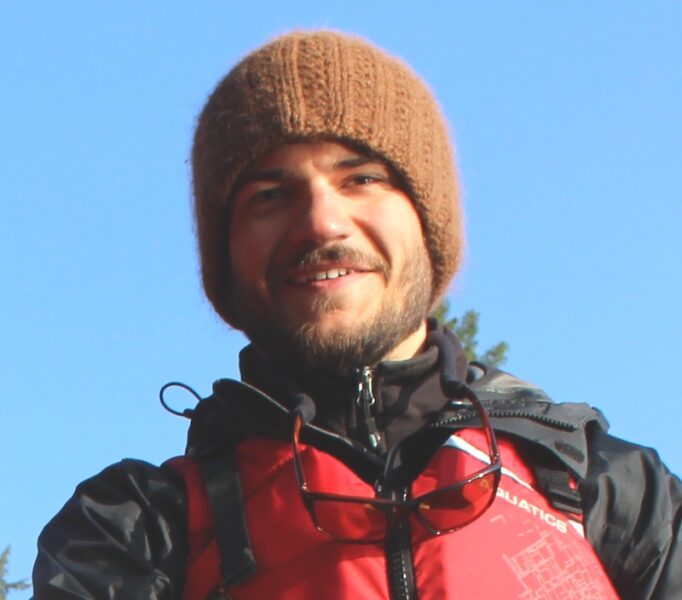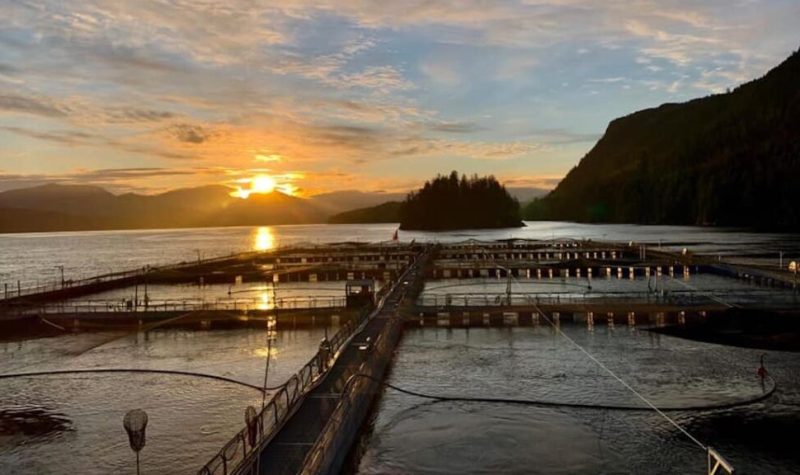By Roy L Hales
Three recent academic papers suggest that salmon farms may pose more than a minimal risk to wild salmon migrating through the Discovery Islands.
In response, the BC Salmon Farmers Association emailed Cortes Currents that while these studies reported the presence of viruses, they did not show they were causing disease in farmed or wild salmon.
Today’s program largely consists of interviews with Dr Andrew Bateman from the Pacific Salmon Foundation (PSF)’s Strategic Salmon Health Initiative (SSHI), one of the scientists involved in these studies, and readings from the industry’s response.
Reservoir for infectious agents
The first of these studies was published last October, the month that Fisheries and Oceans Canada declared the results of its nine assessments.
A University of Toronto led study, “found that the probability of detecting pathogen environmental DNA was 2.72 times higher at active versus inactive salmon farm sites.”
This study was conducted at 58 active and inactive farm sites, over a three year period.
In the paper’s abstract it states, “Our findings suggest that salmon farms serve as a potential reservoir for a number of infectious agents; thereby elevating the risk of exposure for wild salmon and other fish species that share the marine environment.”
Lead author Dylan Shea and four of the twelve contributing scientists were from the University of Toronto’s Department of Ecology and Environmental Biology, but there were also scientists from the DFO’s Pacific Biological Station in Nanaimo, the DFO’s Institute of Ocean Sciences in Sidney, the University of Victoria’s School of Environmental Studies, UBC’s Department of Medicine, and the University of Hawaii’s Department of Earth Sciences.
One of the contributing scientists, Dr Andrew Bateman from the Pacific Salmon Foundation (PSF)’s Strategic Salmon Health Initiative (SSHI), explains, “Technically: We can’t say whether it is the infectious agents themselves, or whether it is just fragments of the DNA that we are detecting that are elevated around farms, but most people would interpret the findings as being suggestive that active Atlantic salmon farms do elevate the infectious burden for certain infectious agents in the marine environment. It is sort of: where there is smoke, there is fire”

Dr Andrew Bateman (on board a boat) – photo submitted by Dr Andrew Bateman
Fish farm response
The BC Salmon Farmers Association (BCFA) emailed that viruses are among the most abundant natural biological agents in the world.
They reject any suggestion that salmon farms are responsible for these viruses, adding that farmed salmon are tested for a number of pathogens before being introduced to ocean pens.
“The recent papers do not explore evidence to show that the detected genetic material or viruses were causing disease either in farmed or wild fish. Further, the presence of genetic material of potential pathogens in the marine environment (as in Shea et al 2020) is not indicative of viable viruses. An important step in studying viruses is to determine whether they are causing disease. These studies did not move beyond detection. Therefore, these papers offer speculative conclusions that these viruses are viable and causing disease,” wrote the industry spokesperson.
Looking at infectious agents
Dr Bateman described the studies as part of a body of work looking into infectious agents in farmed and wild salmon.
“It is very important to know what farmed salmon are infected with and what they may be spreading,” he added.
Proximity to farms
One of the industry criticisms was that “The authors also do not include the measure of distance in proximity to farms from which their samples were taken.”
To which Bateman responded, “We did, indeed, sample water from nearby active farms and away from active farms. The sites away from active farms … were a mix of fallow farms (farms where there is still a farm structure but no fish) combined with decommissioned sites (sites where there is no evidence, to the naked eye, of there having been a farm).”

Figure 1 – Locations of the salmon farms and fish hatcheries used in Bateman et al, Descriptive multi‐agent epidemiology via molecular screening on Atlantic salmon farms in the northeast Pacific Ocean
Studying 58 infectious agents
Last Month, Dr Bateman was the lead author of the paper Descriptive multi‐agent epidemiology via molecular screening on Atlantic salmon farms in the northeast Pacific Ocean, published in Scientific Reports.
He and his colleagues from the DFO’s Molecular Genetics Lab at Pacific Biological Station in Nanaimo, the Pacific Salmon Foundation in Vancouver, and UBC’s Department of Medicine, studied 58 infectious agents found in farmed salmon.
Cutthroat trout virus (CTV-2) and the Atlantic Salmon Calicivirus (ASCV)
Bateman also cited a recent study, whose lead author was Dr Gideon Mordecai from UBC, that dealt with viruses that had not previously been detected in BC. Cutthroat trout virus (CTV-2) and the Atlantic Salmon Calicivirus (ASCV) were among them.
The BC Salmon farmers Association pointed out there had been no evidence on BC salmon farms, or in the wild, that either of these viruses causes disease.
Bateman concurred, “We don’t know what these viruses do, or if they cause disease in wild or farmed salmon. That is one of the outstanding questions.”
He added, “The concern is not that we have hard and fast evidence of a disease, it is that there is a virus and it is infecting fish whether they are farmed or wild. It may cause a problem and it may not.”
Where did BC’s PRV virus originate?
One of the viruses they studied was Piscine orthoreovirus (PRV), one of the nine pathogens the DFO recently declared to be of minimal risk. The strain found in BC (PRV-1) appears to have originated among Atlantic Salmon and arrived when fish farms were introduced during the 1980s.
“There is some debate about the exact timing, but there is pretty much agreement on the fact that PRV-1 arrived in BC from the Atlantic,” said Batemen.
The BC Salmon Farmers Association disagree and, in their email claim that PRV is endemic in BC.
“When and how PRV came to be present in BC are not clear. There have been confirmed detections at the molecular level of PRV-1 in samples dating back to the mid-1980s in Pacific salmon, in 1993 in Washington state Coho salmon and recently in a historical review of data, a Steelhead Trout sample taken in BC in 1977,” their spokesperson wrote.
The BC Salmon Farmer’s Association cited a recent study, co-written by eight scientists, suggesting that while the strains of PVR-1 in Pacific and Atlantic Canada are related, they are genetically distinct. They share a common ancestor with strains from Iceland and Norway. The author does not know when this strain of PRV-1 reached BC waters.
“It could have arrived when more than 8 million wild Atlantic salmon were introduced to BC rivers and streams a century ago between 1905 and 1935, under a federal government program,” they wrote.
Bateman responded, “These kind of studies always have a degree of uncertainty, but we in the Strategic Salmon Health Initiative are of the opinion that the more recent date is more accurate because it combines more of the available data more holistically.”
He added, “All recent studies of which I am aware are in agreement that the PRV we have in BC appears to have come from the Atlantic Ocean.”
Is PRV a serious threat?
In their email, the BC Salmon Farmers Association cites a study that “failed to induce disease or mortality when exposing Pacific (Sockeye and Chinook) and Atlantic Salmon to the BC strain of PRV in a lab-based study.” They concluded, “This suggests PRV in BC has a low ability to cause disease for these species.”
So far, Bateman and his colleagues are also finding that Sockeye is less susceptible to PRV-1 than other salmon.
He added, “Our preliminary analysis indicates that PRV-1 infection in wild fish may be linked with poor ocean survival for wild Coho and wild Chinook salmon. For Chinook in particular, the patterns that we see in terms of spatial infection profile, indicate the levels of infection are higher around salmon farms.”
Tenacibaculum maritimum
One of the other examples Bateman gave was Tenacibaculum maritimum, a bacterium that affects fish around the world.
“We see quite high levels of infection on Atlantic Salmon farms in BC. And we are also beginning to see preliminary evidence that for Chinook and Sockeye Salmon in particular, infection in the wild may be tied to poor survival. Unfortunately, Sockeye salmon, as they are heading north out of the Fraser River, seem to pick up Tenacibaculum around salmon farms in the Discovery Islands,” he said.
This prompted the BC Salmon Farmers Association to cite two studies suggesting that “the disease noted in Atlantic salmon caused by T. maritimum has never been detected in any species of wild Pacific salmon, even though the wild fish may carry the bacterium.”
They pointed out that in addition to being found on salmon, this bacterium has also been identified and isolated from sediment, the surface of tanks, and water cultures.
To which Bateman replied, “Specifically, in Atlantic Salmon farms in British Columbia, Tenacibaculum maritimum causes a disease called mouth rot. That disease, to my knowledge, has not been observed anywhere else.”

Figure 3 – depicting the Agent intensity of four viruses, three of which are discussed in this article – from Bateman et al, Descriptive multi‐agent epidemiology via molecular screening on Atlantic salmon farms in the northeast Pacific Ocean
Not the only threat to salmon survival
Salmon farms are not the only sources of infectious agents and infectious agents are not the only threat to wild salmon.
“Ocean conditions generally: things like food availability, or competition with other species are directly linked to salmon survival. Ocean temperatures in particular, are one thing that predicts the performance of salmon stocks. With warmer temperatures tending to be worse for salmon and all else being equal, this tends to be cause for concern as we move forward and temperatures are warming,” said Bateman
He added, “In any science, there is always room for uncertainty. That is part of the nature of the beast and how we deal with that is part of the process.”
Links of interest:
- (Cortes Currents) – Why the Pacific Salmon Foundation supports the decision to remove open net fish farms
- (CBC) New study suggests fish farms raise risk of exposure to infectious disease for wild B.C. salmon
- (Cortes Currents) articles about the effect warming (fresh and/or ocean) water has on salmon.
- (Scientific Reports) Andrew W Bateman et al, Descriptive multi-agent epidemiology via molecular screening on Atlantic salmon farms in the northeast Pacific Ocean (2021)
- (The Royal Society) Dylan Shea et al, Environmental DNA from multiple pathogens is elevated near active Atlantic salmon farms (2020)
- (Virus Evolution) Gideon J Mordecai et al, Discovery and surveillance of viruses from salmon in British Columbia using viral immune-response biomarkers, metatranscriptomics, and high-throughput RT-PCR (2020)
- (Virus Evolution) Ahmed Shah et al, Genomes reveal genetic diversity of Piscine orthoreovirus in farmed and free-ranging salmonids from Canada and USA (2020)
- (Plus One) Kyle A. Garver et al, Piscine Orthoreovirus from Western North America Is Transmissible to Atlantic Salmon and Sockeye Salmon but Fails to Cause Heart and Skeletal Muscle Inflammation (2016)
- (Journal of fish Diseases) Kyle A. Garver et al, Piscine reovirus, but not Jaundice Syndrome, was transmissible to Chinook Salmon, Oncorhynchus tshawytscha (Walbaum), Sockeye Salmon, Oncorhynchus nerka (Walbaum), and Atlantic Salmon, Salmo salar L. (2015)
- Pacific Salmon Foundation website
- BC Salmon Farmers Association website


